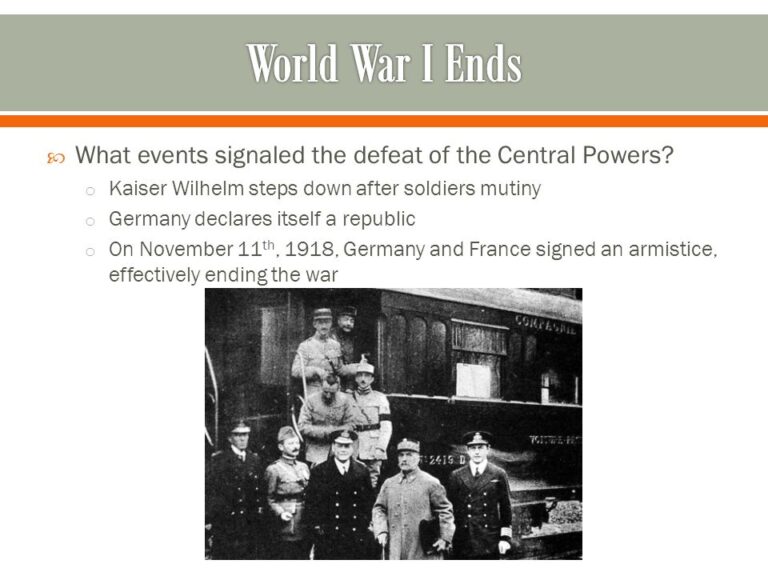The downfall of the Central Powers during World War I was marked by a series of crucial events that highlighted their defeat on the battlefield and on the diplomatic front. Understanding what events signaled the defeat of the Central Powers gives us valuable insights into the end of one of the most significant conflicts in history. From the crippling losses at the Battle of Marne to the entry of the United States into the war and the revolutions that spread across their territories, each event played a vital role in sealing the fate of Germany, Austria-Hungary, the Ottoman Empire, and Bulgaria. Let’s explore these key events that ultimately led to the demise of the Central Powers.
Introduction to the Central Powers
The Central Powers, formed during World War I, were a coalition of countries including Germany, Austria-Hungary, the Ottoman Empire, and Bulgaria. This alliance stood in opposition to the Allies, consisting primarily of France, Russia, Italy, and the United Kingdom. The Central Powers aimed to assert military dominance over Europe and expand their territories through aggressive tactics and strategic warfare.
Key Members of the Central Powers
Germany played a central role in leading the Central Powers, with its formidable military and industrial might. Austria-Hungary, a multi-ethnic empire, sought to maintain its dominance in the Balkans. The Ottoman Empire provided a crucial strategic position, controlling key trade routes in the Middle East. Bulgaria, although a smaller member, contributed troops and resources to the alliance.
Challenges Faced by the Central Powers
Despite initial successes, the Central Powers encountered significant challenges during the course of the war. They faced logistical issues due to diverse languages and cultures within the alliance, making coordination difficult. The blockade imposed by the Allies severely limited the Central Powers’ access to essential resources and weakened their economies.

Unraveling the Alliances of World War I
As World War I reached its climax, several key events signaled the defeat of the Central Powers. One of the pivotal factors contributing to their downfall was the disintegration of their alliances. The web of alliances formed prior to the war began to crumble under the weight of shifting loyalties and military defeats.
Decline of the Triple Alliance
The Triple Alliance between Germany, Austria-Hungary, and Italy started to unravel as Italy withdrew its support in 1915, leaving Germany and Austria-Hungary to face the Entente powers alone. This weakened the Central Powers’ position in the conflict.
Additionally, the entry of the United States into the war in 1917 further tilted the balance in favor of the Allies, as the Central Powers now had to contend with a new and powerful adversary.
Eastern Front Failures
The failures on the Eastern Front also played a crucial role in signaling the defeat of the Central Powers. The Russian Revolution in 1917 led to the collapse of the Eastern Front for Germany and Austria-Hungary, forcing them to redirect their forces westward.
The crumbling Eastern Front exposed the vulnerabilities of the Central Powers and stretched their resources thin, making it increasingly difficult for them to sustain the war effort.
The Turning Point: Key Battles and Shifts in Power
As we delve into the events that marked the defeat of the Central Powers, it becomes evident that certain key battles and shifts in power played a pivotal role in their demise. These events not only reshaped the course of war but also signaled a turning point that ultimately led to the downfall of the Central Powers.
The Battle of Somme
The Battle of Somme in 1916 stands out as a significant turning point in World War I. Fought between British and French forces against the German Empire, this battle resulted in immense casualties and marked a shift in tactics and strategies employed by both sides.
The Entry of the United States
The 1917 entry of the United States into the war on the side of the Allies proved to be a decisive moment. This shift in power added substantial resources and manpower to the Allies, tipping the scales against the Central Powers.
Internal Struggles within the Central Powers
As the Central Powers faced mounting pressure during World War I, internal conflicts exacerbated their downfall. The year what events signaled the defeat of the central powers saw significant rifts within the alliance, hindering their ability to effectively coordinate military strategies.
Political Disagreements
The Central Powers grappled with political disagreements over war tactics and objectives, weakening their unity.
Some leaders prioritized defensive strategies while others advocated for offensive maneuvers, causing internal divisions that impacted their overall performance.
Economic Strains
The economic strains within the Central Powers further eroded their capabilities.
- Inflation and resource scarcity plagued the alliance, affecting their ability to sustain a prolonged war effort.
- The lack of financial resources led to increased discontent among the populace and strained their war machinery.

External Pressures and Collapses
As the Central Powers faced mounting challenges, several key events signaled their eventual defeat. The external pressures exerted by their enemies and internal instabilities led to a series of collapses that marked their demise.
Alliance Strain
The strain within the Central Powers alliance, comprising Germany, Austria-Hungary, Ottoman Empire, and Bulgaria, began to show as differing priorities and strategies emerged. This internal discord weakened their coordinated efforts.
Economic Turmoil
The economic turmoil within the Central Powers further exacerbated their situation. Inflation, resource shortages, and war-induced economic stress hindered their ability to sustain prolonged military campaigns.
- The need for raw materials and food supplies grew dire as blockades restricted imports.
- Hyperinflation eroded the purchasing power of their currencies, causing social unrest.
The Aftermath and Legacy of the Defeat
After the defeat of the Central Powers, several key events signaled their demise. The repercussions of their loss reverberated through the socio-political landscape of Europe, reshaping alliances and power dynamics.
Impact on Global Politics
The defeat of the Central Powers marked a significant shift in global politics, leading to the restructuring of nations and the establishment of new borders. What events signaled the defeat of the Central Powers was the Treaty of Versailles in 1919, which imposed harsh conditions on Germany and set the stage for future conflicts.
Legacy for Future Generations
The legacy of the defeat of the Central Powers continues to affect generations, influencing historical narratives and shaping collective memories. The aftermath of the war left a profound impact on societies, paving the way for changes in governance and international relations.
- The emergence of new ideologies such as fascism and communism.
- The rise of the United States as a global superpower.
- The seeds of future conflicts planted by unresolved issues.
Frequently Asked Questions
-
- What were some key events that led to the defeat of the Central Powers?
- Some key events that led to the defeat of the Central Powers during World War I included the entry of the United States into the war, the collapse of the Ottoman Empire, the mutinies and revolutions in Germany and Austria-Hungary, and the military successes of the Allied Powers.
-
- How did the entry of the United States contribute to the defeat of the Central Powers?
- The entry of the United States into World War I in 1917 significantly weakened the Central Powers. The American troops bolstered the Allied forces, providing fresh manpower and resources that helped turn the tide of the war against Germany and its allies.
-
- What role did the collapse of the Ottoman Empire play in the defeat of the Central Powers?
- The collapse of the Ottoman Empire, a key member of the Central Powers, dealt a major blow to their alliance. The loss of Ottoman territories and resources weakened the overall strength of the Central Powers and put them at a strategic disadvantage.
-
- How did internal unrest in Germany and Austria-Hungary contribute to the defeat of the Central Powers?
- Internal unrest, mutinies, and revolutions in Germany and Austria-Hungary eroded the stability and morale of the Central Powers. These events undermined their ability to effectively coordinate their war efforts and maintain domestic support for the war, ultimately weakening their position on the battlefield.
-
- What were some military successes of the Allied Powers that contributed to the defeat of the Central Powers?
- The Allied Powers achieved significant military successes on various fronts that led to the defeat of the Central Powers. Key victories, such as the Battle of Amiens, the Meuse-Argonne Offensive, and the Salonika Front breakthrough, gradually pushed back the Central Powers and hastened their downfall.
Final Thoughts: The Defeat of the Central Powers
In conclusion, the demise of the Central Powers was marked by several key events that signaled their defeat. The battles of the Marne, Jutland, and the Somme showcased the declining strength of the Central Powers and the rising power of the Allies. The entry of the United States into the war provided crucial support that shifted the balance of power. The collapse of Austria-Hungary and the Ottoman Empire further weakened the Central Powers. Ultimately, the signing of the Armistice in 1918 sealed their fate. These events highlighted the importance of strategic alliances, technological advancements, and effective leadership in determining the outcome of a war on a global scale.



